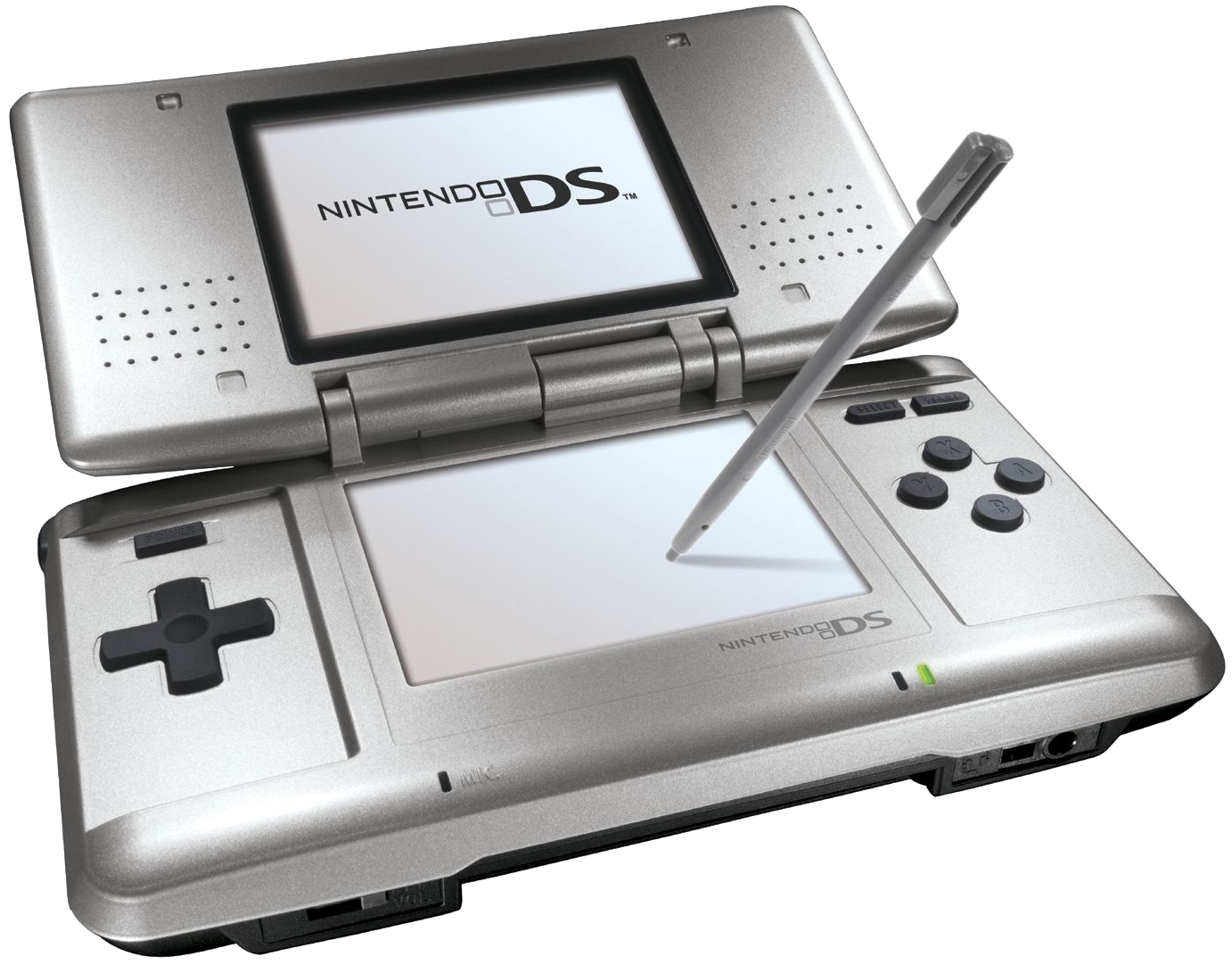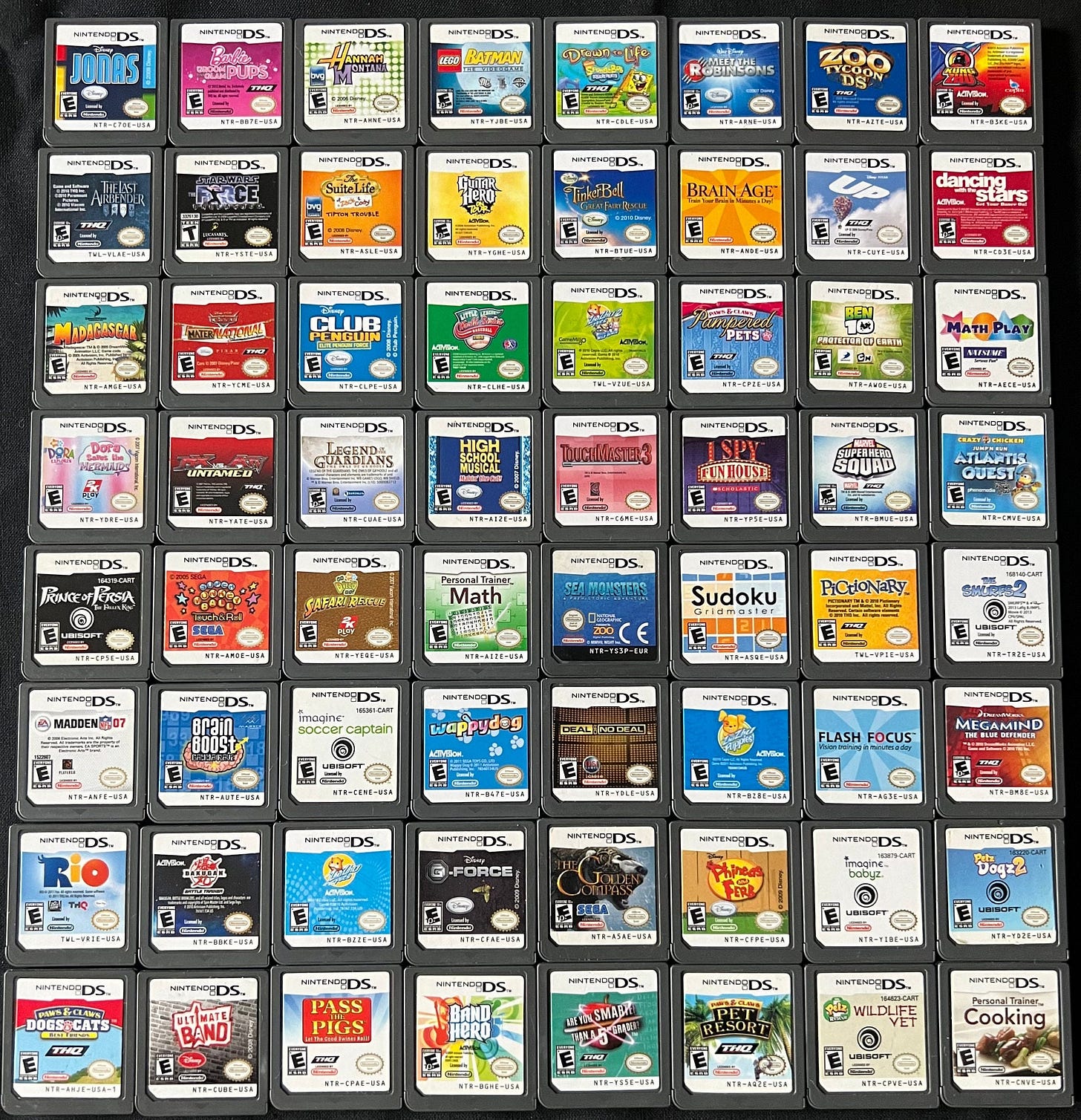The Nintendo DS was ubiquitous growing up in the 2000’s. No matter where I went on holiday, what school I went to or whichever members of extended family I met up with, every kid had one. At 154 million units sold (that’s 2 million more than the Switch even) the DS stands as the second best-selling console of all time and you really felt that back in the day too.
But was it a good console? Was its library of games worth owning? And has it really left a legacy? Let’s find out.
Hardware **** 4 Stars
The Nintendo DS was the first handheld Nintendo released that finally had no major flaws in any of its models; all features and expectations of a modern handheld device were present and fulfilled and the inclusion of Wi-Fi and a touch-screen, in 2004, on a device primarily marketed towards children and casual gamers, meant that the DS also far exceeded expectations.
Part of why I think the DS deserves such a high score is that the fundamental idea of the console was just brilliant. Back in 2004, smart devices and touch-screens were really starting to take off, with PDA’s and tablets gaining ground in the consumer market, so Nintendo threw a lot of those features: a calendar, note taking, a clock and an alarm just to name a few, into the DS, gave it internet connectivity and successfully captured the rest of the household like never before; even your grandparents, aunties and uncles had a DS. The book-like form factor, games like Dr Kawashima’s Brain Training, digital recipe books, it all came together into the perfect trojan horse; your parents bought it for Brain Age but the pull of nostalgia was strong and when they saw Little Timmy playing the new Mario on his DS: 2D just like the old ones, more than a few ‘mature’ DS owners also wanted in.
Another good thing about the Nintendo DS is that each subsequent model only improved on the design, unlike the mixed-bag of chopped and changed features that plagued the Gameboy Advance family. Some people might be tempted to criticise the DSi for cutting out Gameboy Advance support but the first 2 models of Nintendo DS were backwards compatible anyway and by the time of the DSi’s late-2008 release date, I don’t think people were chomping at the bit to play the GBA library anymore.
So why not 5 stars? Well, I think the top rating for hardware should only go to the least-flawed and objectively most capable system of a generation and unfortunately, the Nintendo DS just doesn’t quite hit the mark. Sony’s PlayStation Portable was indisputably the more powerful console and the DS’ lack of an analogue stick dogged it throughout its life.
Software: **** 4 Stars
The Nintendo DS has a fantastic library of games: better than those on the GBA in my opinion and unlike that console, I don’t feel that a good 1/3 of the overall library was ports or remakes.
On the Nintendo first party front we do have Super Mario 64 DS but like I explained in my post on the Advance, I think the game does enough different to appeal to fans of the original and to those who never played it; portability will always be a selling point for me too, I do everything at my desk so sometimes it’s nice to game in bed. We also have games like the original New Super Mario Bros. which is kind of frowned on now but back then? This was something fresh and a return to form. Mario Kart DS is generally considered miles better than Super Circuit, Nintendogs was a seismic hit around this time too, it even spawned a bit of a wave of dog-themed games for a while and the Mario & Luigi series got a start on this console. You do also have Metroid Prime: Hunters and the DS Legend of Zelda games as well, now these aren’t exactly considered the cream of the crop but they’ll do in a pinch.
Another huge boon for this handheld’s library is that all the best Pokémon games are playable on DS. If you have an original DS or DS Lite, that cartridge slot gives you access to the Generation III games while the DS itself had a rich pantheon of mainline Pokémon games and remakes released for it like Soul Silver and Heart Gold, Diamond, Pearl and Platinum and Pokémon Black and White. I’m not sure how other Pokémon players feel but my general opinion on the franchise is that it it slowly got worse and worse once it left the DS so this represents a bit of a golden age to me.
The Nintendo DS’ third party games were pretty awesome too. GTA: China Town Wars, although cross-platform, played very well, on the DS and was a return to the series’ top-down roots; I remember particularly enjoying some of the DS Lego games as a kid too. These days? Trackmania is one of my go-to pick up and play titles on the Nintendo DS, I really enjoy that one. You shouldn’t ignore the Professor Layton series either, those were a massive hit.
Once again though, I don’t feel I can give the DS the full 5 stars because there is a lot of shovelware crap on the console but also because, when you stack it up against the PSP, DS games tend to look a bit twee; China Town Wars is cool and so is Mario Kart DS but PSP owners got full-fat, PS2-level GTA games on that handheld and that console in general was the first, at least to me, that really felt like it provided console games but on the go.
Impact: ***** 5 Stars
The Nintendo DS is the most successful handheld console in history.
The DS helped keep Nintendo competitive and financially stable even while the Gamecube lay mangled under the PS2’s boot, it trounced the, frankly, far superior hardware and features of the PlayStation Portable by providing the games that players cared about most at the best price, and it ushered in Nintendo’s brief resurgence back to the top of the industry in the mid-2000’s.
This console was so ubiquitous that I can count the people I’ve met who didn’t have one on my right hand.
So many times I’ve met non-gamers that had a DS, or still have one locked in a drawer somewhere from their childhood, growing up, I saw grandparents and older people regularly whip out a DS for some Brain training or Animal Crossing. The Nintendo DS was a sensation but unlike the Wii, it had staying power and remained culturally and fiscally relevant right up until its successor took over, selling 27 million units: just a million less than the Series X as of last year, in its final full year on the market alone.
Sentiment: ***** 4 Stars
I think it should be obvious by now that I really love the Nintendo Dual-Screen (that just doesn’t sound right, does it?) While the Gamecube, which was still the newest home console from Nintendo when the DS launched, had an inconsistent and eclectic library in my opinion, the DS is one of the few devices that bridged that gap between the Nintendo core fanbase and the wider community; it also brought millions of new fans into the ecosystem. Not only was it the it the ideal budget alternative to the PSP, which was a full $100 more expensive in the US and about £80 more expensive in the UK but it had a much more appealing image to the parents who would inevitably be buying it too; the DS was Mario, Nintendogs, Pictochat and Kirby whereas the PSP was Grand Theft Auto, Metal Gear Solid and God of War. You couldn’t bring games like that to school.
I had a lot of hand-me-downs as a kid, so I was lucky enough to own both of these handhelds and have affection for both and the PSP was actually my first time playing online multiplayer in a video game. I was always impressed with the PSP’s graphics and premium feel but something about that console felt delicate and the price only made me less eager to take it anywhere whereas the DS was a little chunky brick and could survive a good fall if you dropped it.
The PSP was a PS2 for when you couldn’t play your PS2, so when I was at home with my full-fat consoles, I rarely saw fit to switch it on. The DS had its own appeal with that Pokémon library and the first 2D Mario in years but more than that, it has most of the memories for me; where I was, my DS was and vice versa. Every holiday, every long car journey and every appointment, Nintendo’s scrappy little square followed me to France, Portugal and the USA and back. It always found its way back into my palms and still does today.
Final Score: 17/20
Join me next time for my review of Nintendo’s final thoroughbred handheld: the Nintendo 3DS. If you enjoyed the post then be sure to Subscribe to Scanlines’ Journal for new letters straight to your inbox roughly every 3 days. This series may be coming to an end but believe me, I have much more planned for the future.








The DS had a really unique library with some games that I still think hold up better than almost anything that's come since - Contra 4, the two Castlevanias, Rocket Slime, and Retro Game Challenge [the English port of the Gamecenter CX game]. It really was a sort of sweet spot, with just enough technical power to make for gorgeous 2D games without opening the door to the crutch of mediocre 3D graphics, enough exclusivity and a lack of a big PC indie scene to push developers into putting the effort in on making use of the DS's features and market, and almost perfect hardware and control layout for the era [aside from a lack of analog]. The dual screens weren't always necessary, but they felt like a proper evolution of the experimentation from systems like the Dreamcast, and when a game made good use of them or the touchscreen it was hard to beat.
Admittedly, I remember thinking Nintendo was crazy when I first heard that they were making a handheld with two screens. Once I saw it in action and realized it’s a clamshell design, then I was sold on it.
The DS is one of my favorite handhelds from the time in gaming. Loved me some Meteos. I still have all my original DS purchases.